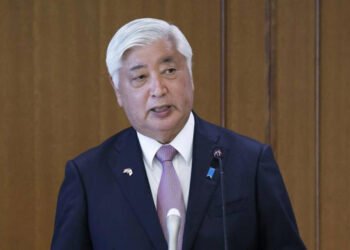The Japanese government has announced that treated radioactive wastewater from the Fukushima Daiichi nuclear power plant will be released into the ocean as early as Thursday, August 24, 2023.
Prime Minister Fumio Kishida gave the final approval at a meeting of Cabinet ministers involved in the plan and instructed the operator, Tokyo Electric Power Company (TEPCO) Holdings, to be ready to start the release on Thursday if weather and sea conditions are favourable.
The water release begins nearly 12 and half years after the March 2011 nuclear meltdowns caused by a massive earthquake and tsunami.
In 2011, Japan experienced an earthquake and tsunami which caused water within the Fukushima nuclear plant to be contaminated with highly radioactive material. Since then, new water has been pumped in to cool fuel debris in the reactors, while ground and rainwater have leaked in, creating more radioactive wastewater.
All this wastewater has so far been treated and stored in massive tanks. However, space is running out and authorities say that they need to get rid of the water to safely decommission the plant. Hence the plan to release the water into the ocean.

Speaking to Cabinet members, Kishida stressed that the water release was “an issue that absolutely cannot be put off” to “achieve the recovery of Fukushima and decommissioning” of the nuclear plant.
Kishida stated that the government has done everything for now to ensure the safety, combat the reputational damage for the fisheries and to provide transparent and scientific explanation to gain understanding in and outside the country.
He also promised that the government will continue the effort until the end of the release and decommissioning.
The decision follows months of deliberation on the government’s side and comes a day after Kishida welcomed the head of the National Federation of Fisheries Cooperative Associations, or Zengyoren, at the Prime Minister’s office in an attempt to gain the association’s approval for the controversial release.
During the meeting on Monday, August 21, 2023, Masanobu Sakamoto, the Chairman of the association, confirmed the group’s opposition to the plan, while adding that the proposal had obtained a certain degree of understanding within the fishing industry.
Even though the government and TEPCO claim that the treatment and dilution will make the wastewater safer than international standards and its environmental impact will be negligibly small, a number of scientists say that long-term impact of the low-dose radioactivity that remains in the water needs attention.
Additional ¥50 billion To Be Earmarked To Support The Fishing Industry

The government has agreed to establish a ¥30 billion ($205.8 million) fund to address any additional damage following the discharge. On top of that, upon pressing requests from the fishing industry, an extra ¥50 billion will be earmarked to support the industry.
All attention will now be focused on the Futaba district of Fukushima Prefecture, the location of the disabled plant, where over 1.34 million tons of water, cleansed of all its radioactive material except tritium, will be gradually poured into the ocean through an underwater tunnel.
According to Japanese officials, the water will be diluted to one 40th of the concentration permitted under Japanese safety standards before being pumped into the ocean over the next 30 to 40 years via an underwater tunnel 1km from the coast.
Per a report issued early last month by the International Atomic Energy Association (IAEA) endorsing the release, tritium does not cause significant damage to the environment if kept within regulatory levels.
However, concerns among local fishing communities remain high, as the industry has already been suffering from reputational damage for more than a decade.
Japanese fisheries groups have opposed the plan out of worry of further damage to the reputation of their seafood. Groups in China and South Korea have also raised concern, making it a political and diplomatic issue.



















